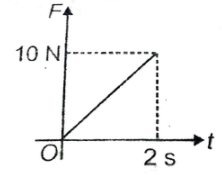Due to the application of a force on a body of mass 100 kg that is initially at rest, the body moves with an acceleration of 20ms−2 in the direction of the force. Find the magnitude of the force.
The correct Answer is:2000N
To solve the problem, we will apply Newton's second law of motion, which states that the net force acting on an object is equal to the mass of the object multiplied by its acceleration. The formula can be expressed as:
F=m⋅a
Where:
- F is the net force,
- m is the mass of the object,
- a is the acceleration of the object.
1. Identify the given values:
- Mass of the body, m=100kg
- Acceleration of the body, a=20m/s2
2. Substitute the values into the formula:
F=m⋅a
F=100kg⋅20m/s2
3. Calculate the force:
F=2000kg⋅m/s2
Since 1kg⋅m/s2 is equivalent to 1 Newton (N), we can express the force in Newtons:
F=2000N
4. Conclusion:
The magnitude of the force applied to the body is 2000N.
- F is the net force,
- m is the mass of the object,
- a is the acceleration of the object.
- Mass of the body, m=100kg
- Acceleration of the body, a=20m/s2
F=m⋅a
F=100kg⋅20m/s2
F=2000kg⋅m/s2
Since 1kg⋅m/s2 is equivalent to 1 Newton (N), we can express the force in Newtons:
F=2000N
The magnitude of the force applied to the body is 2000N.
Topper's Solved these Questions
- LAWS OF MOTIONBOOK - AAKASH SERIESCHAPTER - LAWS OF MOTIONEXERCISE - NUMERICAL EXERCISE ( LEVEL-2)
13 Videos
- LAWS OF MOTIONBOOK - AAKASH SERIESCHAPTER - LAWS OF MOTIONEXERCISE - QUESTIONS FOR DESCRIPTIVE ANSWER
5 Videos
- LAWS OF MOTIONBOOK - AAKASH SERIESCHAPTER - LAWS OF MOTIONEXERCISE - VERY SHORT ANSWER TYPE QUESTIONS
13 Videos
- GEOMETRICAL OPTICSBOOK - AAKASH SERIESCHAPTER - GEOMETRICAL OPTICSEXERCISE - ADDITIONAL PRACTICE EXERCISE (LEVEL-II PRACTICE SHEET (ADVANCED) INTEGER TYPE QUESTIONS)
10 Videos
- LOGIC GATESBOOK - AAKASH SERIESCHAPTER - LOGIC GATESEXERCISE - Exercise (Very Short Answer)
10 Videos
Similar Questions
A force acts for 0.1 s on a body of mass 2.0 kg initially at rest. The force is then withdrawn and the body moves with a velocity of 2m s−1. Find the magnitude of the force.
View SolutionA force acts for 0.1 s on a body of mass 1.2 kg initially at rest. The force then ceases to act and the body moves thorugh 2 m in the next 1.0 s . Find the magnitude of force.
View SolutionA force acts for 0.1 s on a body of mass 2 kg initially at rest. The force is then withdrawn and the body moves with a velocity of 2 m/s. Find the magnitude of force.
View SolutionA force acts for 0.1 s on a body of mass 2 kg initially at rest. The force is then withdrawn and the body moves with a velocity of 2 m/s. Find the magnitude of force.
View SolutionA force is applied for a duration of 10sec on a body of mass 5kg that is at rest. As a result the body acquires a velocity of 2ms−1. Find the magnitude of the force applied.
View SolutionA body is moving with an acceleration 'a' under the action of a force 'g'. The weight of the body is
View SolutionA force acts for 10 s on a stationary body of mass 100 kg, after which the force ceases to act. The body moves through a distance of 100 m in the next 5 s. Calculate: The magnitude of the force.
View SolutionA variable force acts on a body of mass 2 kg intially at rest as shown in figure . Calculate the impulse of the force in first 2 seconds and speed of the body after 2 seconds .

View SolutionA force of 10 N acts on a body of mass 2 kg for 3s , initially at rest. Calculate change in momentum of the body.
View SolutionA body of mass 2kg starts from rest and moves with uniform acceleration. It acquires a velocity 20ms−1 in 4s.
The power exerted on the body at 2s is
View Solution
